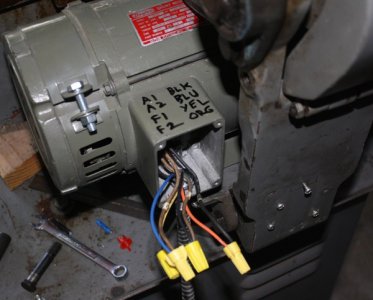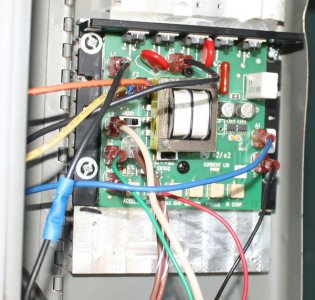- Joined
- Sep 26, 2013
- Messages
- 408
Found a few things on this site, seems like a good info source:
https://www.americancontrolelectronics.com/t-faq.aspx#tech1 ( formerly Minarik)
Why is my motor producing a loud humming/buzzing sound?
If the motor is producing this type of sound, a non-filtered SCR type drive is probably being used to run it. SCR type drives pulse a motor with voltage 120 times per second. The sound that is heard is the magnetic fields energizing and breaking down inside the motor at 120Hz. Although this is normal, a PWM type drive is a good choice if the hum is not acceptable in the application.
What is a line filter?
A line filter is a device typically connected in between the AC line source and the input of a drive. A line filter is designed to prevent electrical noise from entering a drive. Line filters are commonly used in applications where electrical noise is generated, such as in welding applications. SCR type drives are most commonly affected by line noise due to their reliance on a clean AC waveform for switching purposes.
The drive is SCR type, I have an AC line filter from a treadmill, it may help with the pulsing/oscillating, yes?
Why does my motor oscillate / not run smoothly?
#1 I'll try adjusting the IR comp as noted.
#2 Its running on a speed pot now so does this apply in some way?
#3 Not running under load
#4 Brushes look good, commutator(think thats right) is not shiny copper, maybe carbon build up from the brushes?
#5 I'm running on 230VAC
I'm off to do a little tweaking and take a few pics.
Brian
https://www.americancontrolelectronics.com/t-faq.aspx#tech1 ( formerly Minarik)
Why is my motor producing a loud humming/buzzing sound?
If the motor is producing this type of sound, a non-filtered SCR type drive is probably being used to run it. SCR type drives pulse a motor with voltage 120 times per second. The sound that is heard is the magnetic fields energizing and breaking down inside the motor at 120Hz. Although this is normal, a PWM type drive is a good choice if the hum is not acceptable in the application.
What is a line filter?
A line filter is a device typically connected in between the AC line source and the input of a drive. A line filter is designed to prevent electrical noise from entering a drive. Line filters are commonly used in applications where electrical noise is generated, such as in welding applications. SCR type drives are most commonly affected by line noise due to their reliance on a clean AC waveform for switching purposes.
The drive is SCR type, I have an AC line filter from a treadmill, it may help with the pulsing/oscillating, yes?
Why does my motor oscillate / not run smoothly?
- IR Comp Adjustment: Most drives have this adjustment. If set too far clockwise the motor will tend to oscillate. Slowly turn the IR Comp trim pot in the counter clockwise direction until the oscillation stops.
- Speed command signal: An unstable speed command signal to the drive can cause the motor not to run smoothly. Remove the command signal from the drive and use a potentiometer instead. If the motor becomes smooth, the external speed command signal was the source of the problem.
- Change in load: In most applications a drive can be tuned to run a motor smoothly and compensate for changes in load. But when loads change abruptly, the IR Comp circuit cannot respond fast enough. Make sure there are no mechanical problems in the operation that can cause these abrupt changes in load. A good way to check this is to simply remove the load from the motor and observe how it runs. If operation becomes smooth, you most likely have a mechanical obstruction.
- Motor brushes: If using a permanent magnet motor, inspect the brushes for excessive wear or irregular wear. It also a good idea to blow compressed air into the brush housing to clean out any carbon build up. If possible, turn the motor shaft as you blow compressed air into the brush compartment.
- Max speed too high: Having the output voltage to the motor set too high can cause some drives armature output to become unstable. Do not try to run a motor that exceeds the armature voltage that is available to use. For example, you can’t run a 180VDC rated motor when you power a drive with 115VAC.
#1 I'll try adjusting the IR comp as noted.
#2 Its running on a speed pot now so does this apply in some way?
#3 Not running under load
#4 Brushes look good, commutator(think thats right) is not shiny copper, maybe carbon build up from the brushes?
#5 I'm running on 230VAC
I'm off to do a little tweaking and take a few pics.
Brian



